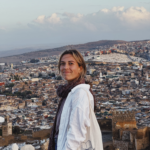Bridging Borders: Lessons on Justice, Peace, and Faith from Mexico to Palestine
By: Adysen Bourbonnais Moylan, Former CMEP Trips Coordinator
Recently, I had the privilege of traveling to the U.S.-Mexico border with an organization called Border Perspective. Border Perspective is run by a local immigrant family who desires to “help transform the immigration conversation and influence people of faith to make informed decisions about how to handle the complex political environment surrounding the border and the perception of immigrants living among us.” The trip was “multi-narrative” so that anyone, regardless of their predisposed opinions, could leave with a comprehensive understanding of what is happening on the ground, including an accurate historical and political context. During the trip, I met with border patrol agents, immigrants who had just entered the U.S. hours before, and members of the local immigrant church. I learned about the critical history of situations driving immigration from Central and South America and the difficulties and complexities faced by those entering the U.S.
Standing at the border on the first day of the trip, I could not help but think of my first trip to Israel and Palestine, so overwhelmed by the amount of information I was taking in as I met people with different narratives and stances of the “other” and the situation they lived in. I also learned interesting facts, such as how the surveillance blimps used by border patrol are bought from Israel. The border fence erected at certain locations between Mexico and the U.S. was modeled after the separation barrier between Israel and the West Bank. There are many similarities between the militarization of our border and the militarization of Israel and Palestine.
One of my favorite places we visited was Jackson Ranch, built by Nathaniel Jackson, a Cherokee, and 11 formerly enslaved people. The ranch is on the original border and served as a haven for escaped slaves from the southern states as Nathaniel worked on the Underground Railroad. In 1893, a U.S. army officer at Fort Brown reported that the ranch was a “negro settlement which has grown up from ran-away slaves being settled and intermarried with Mexicans.” In the face of racism, hate, and bigotry, they created a safe place for people to belong to one another and worship God, the God of justice and righteousness. We can learn a lot from them, and similarly to those in Israel and the occupied Palestinian territories who choose to fight racism, hate, and seek the God of justice and righteousness.
Traveling to politically and religiously polarizing places or confronting your ideas about “the other” are some of the best opportunities to learn and engage with areas where you may lack compassion or are not pursuing peace. I would love to invite you to travel with us, to “come and see,” and to become a learner and peacebuilder in a whole new way.
Let us pray:
Eternal God, in whose perfect kingdom no sword is drawn but the sword of righteousness, no strength known but the strength of love: So mightily spread abroad your Spirit, that all peoples may be gathered under the banner of the Prince of Peace, as children of one Father; to whom be dominion and glory, now and for ever. Amen. (Source: The Book of Common Prayer)

About the Author: Adysen has been connected to CMEP since she learned about the work of CMEP on her first trip to the Middle East. She is a graduate student studying Conflict Analysis and Resolution in the D.C. area. After traveling to the Middle East and North Africa she became passionate about reshaping Western narratives regarding the region and inviting others to visit and do the same.

